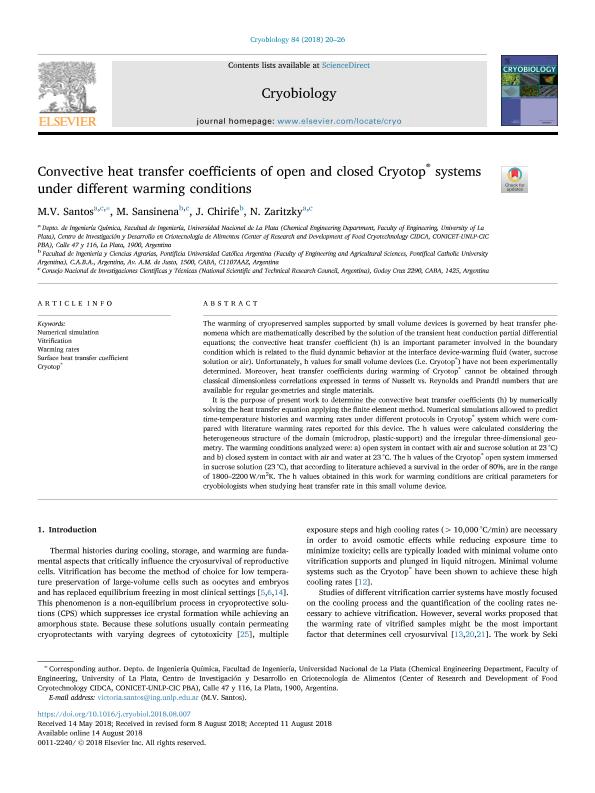Mostrar el registro sencillo del ítem
dc.contributor.author
Santos, Maria Victoria

dc.contributor.author
Sansinena, Marina Julia

dc.contributor.author
Chirife, Jorge

dc.contributor.author
Zaritzky, Noemi Elisabet

dc.date.available
2019-10-22T12:25:00Z
dc.date.issued
2018-10
dc.identifier.citation
Santos, Maria Victoria; Sansinena, Marina Julia; Chirife, Jorge; Zaritzky, Noemi Elisabet; Convective heat transfer coefficients of open and closed Cryotop ® systems under different warming conditions; Academic Press Inc Elsevier Science; Cryobiology; 84; 10-2018; 20-26
dc.identifier.issn
0011-2240
dc.identifier.uri
http://hdl.handle.net/11336/86805
dc.description.abstract
The warming of cryopreserved samples supported by small volume devices is governed by heat transfer phenomena which are mathematically described by the solution of the transient heat conduction partial differential equations; the convective heat transfer coefficient (h) is an important parameter involved in the boundary condition which is related to the fluid dynamic behavior at the interface device-warming fluid (water, sucrose solution or air). Unfortunately, h values for small volume devices (i.e. Cryotop ® ) have not been experimentally determined. Moreover, heat transfer coefficients during warming of Cryotop ® cannot be obtained through classical dimensionless correlations expressed in terms of Nusselt vs. Reynolds and Prandtl numbers that are available for regular geometries and single materials. It is the purpose of present work to determine the convective heat transfer coefficients (h) by numerically solving the heat transfer equation applying the finite element method. Numerical simulations allowed to predict time-temperature histories and warming rates under different protocols in Cryotop ® system which were compared with literature warming rates reported for this device. The h values were calculated considering the heterogeneous structure of the domain (microdrop, plastic-support) and the irregular three-dimensional geometry. The warming conditions analyzed were: a) open system in contact with air and sucrose solution at 23 °C) and b) closed system in contact with air and water at 23 °C. The h values of the Cryotop ® open system immersed in sucrose solution (23 °C), that according to literature achieved a survival in the order of 80%, are in the range of 1800–2200 W/m 2 K. The h values obtained in this work for warming conditions are critical parameters for cryobiologists when studying heat transfer rate in this small volume device.
dc.format
application/pdf
dc.language.iso
eng
dc.publisher
Academic Press Inc Elsevier Science

dc.rights
info:eu-repo/semantics/openAccess
dc.rights.uri
https://creativecommons.org/licenses/by-nc-nd/2.5/ar/
dc.subject
CRYOTOP®
dc.subject
NUMERICAL SIMULATION
dc.subject
SURFACE HEAT TRANSFER COEFFICIENT
dc.subject
VITRIFICATION
dc.subject
WARMING RATES
dc.subject.classification
Otras Ingeniería Química

dc.subject.classification
Ingeniería Química

dc.subject.classification
INGENIERÍAS Y TECNOLOGÍAS

dc.title
Convective heat transfer coefficients of open and closed Cryotop ® systems under different warming conditions
dc.type
info:eu-repo/semantics/article
dc.type
info:ar-repo/semantics/artículo
dc.type
info:eu-repo/semantics/publishedVersion
dc.date.updated
2019-10-15T14:12:14Z
dc.journal.volume
84
dc.journal.pagination
20-26
dc.journal.pais
Estados Unidos

dc.description.fil
Fil: Santos, Maria Victoria. Provincia de Buenos Aires. Gobernación. Comisión de Investigaciones Científicas. Centro de Investigación y Desarrollo en Criotecnología de Alimentos. Consejo Nacional de Investigaciones Científicas y Técnicas. Centro Científico Tecnológico Conicet - La Plata. Centro de Investigación y Desarrollo en Criotecnología de Alimentos. Universidad Nacional de la Plata. Facultad de Ciencias Exactas. Centro de Investigación y Desarrollo en Criotecnología de Alimentos; Argentina
dc.description.fil
Fil: Sansinena, Marina Julia. Provincia de Buenos Aires. Gobernación. Comisión de Investigaciones Científicas. Centro de Investigación y Desarrollo en Criotecnología de Alimentos. Consejo Nacional de Investigaciones Científicas y Técnicas. Centro Científico Tecnológico Conicet - La Plata. Centro de Investigación y Desarrollo en Criotecnología de Alimentos. Universidad Nacional de la Plata. Facultad de Ciencias Exactas. Centro de Investigación y Desarrollo en Criotecnología de Alimentos; Argentina
dc.description.fil
Fil: Chirife, Jorge. Pontificia Universidad Católica Argentina "Santa María de los Buenos Aires". Facultad de Ciencias Agrarias; Argentina
dc.description.fil
Fil: Zaritzky, Noemi Elisabet. Provincia de Buenos Aires. Gobernación. Comisión de Investigaciones Científicas. Centro de Investigación y Desarrollo en Criotecnología de Alimentos. Consejo Nacional de Investigaciones Científicas y Técnicas. Centro Científico Tecnológico Conicet - La Plata. Centro de Investigación y Desarrollo en Criotecnología de Alimentos. Universidad Nacional de la Plata. Facultad de Ciencias Exactas. Centro de Investigación y Desarrollo en Criotecnología de Alimentos; Argentina
dc.journal.title
Cryobiology

dc.relation.alternativeid
info:eu-repo/semantics/altIdentifier/doi/https://doi.org/10.1016/j.cryobiol.2018.08.007
dc.relation.alternativeid
info:eu-repo/semantics/altIdentifier/url/https://www.sciencedirect.com/science/article/pii/S001122401830172X
Archivos asociados
